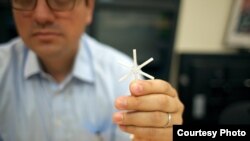Researchers have developed a long-lasting capsule that, when swallowed, slowly releases medicine into the body.
The researchers say the capsule was developed for treatment of the disease malaria. But they believe it could hold medicines for a number of health problems.
Once inside the stomach, the plastic capsule opens up to release the drug in small, measured amounts. The plastic is designed to resist the stomach’s acidic environment. The device breaks down after about two weeks and is expelled with waste products. At that time, a patient would swallow another drug-containing capsule.
Researchers have tested capsules filled with the drug ivermectin on pigs and dogs. Ivermectin is used to treat parasitic organisms. It kills mosquitoes that carry the malaria parasite.
Scientists are now designing a program to test the capsule in people next year.
The scientists work with the Massachusetts Institute of Technology and Brigham and Women’s Hospital in Massachusetts. They decided to test ivermectin because of what they saw when it was used to treat river blindness in Africa. Many people there have malaria infections. Ninety percent of malaria cases worldwide happen in countries south of the Sahara Desert.
Researcher Giovanni Traverso works at Brigham and Women’s Hospital.
“What was observed was that malaria would transiently drop. And so what we proposed was, you know, ‘what if we could increase the period of time during which individuals could have ivermectin in their system really to help suppress the mosquito population in those regions?’”
Researchers say the capsule could possibly be filled with ivermectin and another drug to decrease the number of malaria infections.
The World Health Organization says only about half of people in the West and 30 percent of those in developing countries take their medicine every day when told by doctors to do so. A computer model estimates that the capsule could increase that number to 70 percent.
Massachusetts Institute of Technology researcher Andrew Bellinger agrees.
“You can take advantage of the fact that patients don’t have to be reminded every day that they need to take their medicine. They can remember once a week to take their medicine and then live normally the rest of the time.”
Researchers say the capsule could be used to treat emotional disorders, diabetes, and cardiovascular and kidney diseases.
A study on the capsule and its development was published in the journal, Science Translational Medicine.
I’m Christopher Jones-Cruise.
Jessica Berman wrote this story for VOANews. Christopher Jones-Cruise adapted it for Learning English. George Grow was the editor.
We want to hear from you. Write to us in the Comments Section, or visit our Facebook page.
______________________________________________________________
Words in This Story
capsule – n. a very small container that is filled with medicine and swallowed whole
acidic – adj. of or related to the qualities of an acid
parasite – adj. of or related to an animal or plant that lives in or on another animal or plant and gets food or protection from it
transiently – adv. not lasting long
region – n. a part of a country, of the world, etc., that is different or separate from other parts in some way
gradually – adv. moving or changing in small amounts; happening in a slow way over a long period of time
dissolve – v. to mix with a liquid and become part of the liquid









